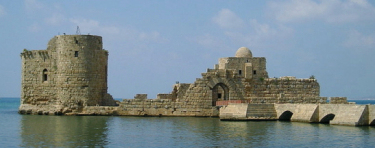Ancient Sidon was known for its skilled artisans who produced art made of bronze and silver. It was also known for skilled woodsmen (1Kings 5:6) and for producing textiles that were dyed purple. Its skills in artwork were noted in both the Iliad and the Odyssey written by Homer (International Standard Bible Encyclopedia article on city).
The city of Sidon was named after the man who founded it who was the firstborn son of Canaan (Genesis 10:15, 1Chronicles 1:13). Canaan, founder of the Canaanites, was the son of Ham, one of the three sons of Noah who survived the great flood (Genesis 10:6). The Biblical patriarch Israel (Jacob) prophesied that, in the end time, the descendants of his son Zebulun would live near the powerful city of Sidon (Genesis 49:13).
Before Israel had a human king over them, those who lived in Sidon were some of the many groups of people whom God allowed to oppress them when they sinned (Judges 10:12).

The Bible states King Solomon married at least one "strange" or non-Israelite woman from Sidon (1Kings 11:1), which one tradition states was a daughter of Hiram, king of Tyre (Barnes' Notes on the Bible, note on 1Kings 11:1). This wife, like several others in his concubine, led him to worship false (pagan) gods.
For it came to pass when Solomon was old, his wives turned away his heart after other gods. And his heart was not perfect with the Lord his God as was the heart of David his father, For Solomon went after Ashtoreth, the goddess of the Sidonians . . . (1Kings11:4 - 5, HBFV throughout).
King Ahab, the eighth ruler of the Northern ten tribes of Israel (reigned 874 to 863 B.C.), like Solomon, married a woman from Sidon who led him away from worshipping the true God. She, however, was not just any woman, but the notorious Jezebel, daughter of the King of Sidon. She is one of the most evil people in the Bible and a symbol of leading people away from the Eternal through false doctrine (1Kings 16:30 - 31, see also Revelation 2:20 - 23).
Paul's Short Visit
Paul, after his arrest in Jerusalem in 58 A.D., is taken to Caesarea to await his hearing before the Roman Governor of the area. After languishing in prison for more than two years he is allowed to travel to Rome to have his case heard by Caesar (Acts 25:21, 27:1 - 2).
Escorted by a Centurion, the Apostle Paul is put on a boat and sails to Sidon. During his short stay in the city, he is allowed the liberty to visit fellow brethren (Acts 27:3). A well-known resource on Paul's life and journeys states the following regarding his trip to the city and its role in Israelite history.
"The passage from Caesarea to Sidon is sixty-seven miles (almost 108 kilometers), a distance easily accomplished, under favorable circumstances, in less than twenty-four hours. In the course of the night, they would pass by Ptolemais and Tyre, where Apostle Paul had visited the Christians two years before.
"Sidon is the last city on the Phoenician shore in which the Apostle's presence can be traced. It is a city associated, from the earliest times, with patriarchal and Jewish history (Life and Epistles of Apostle Paul, chapter 23, section on Sidon).